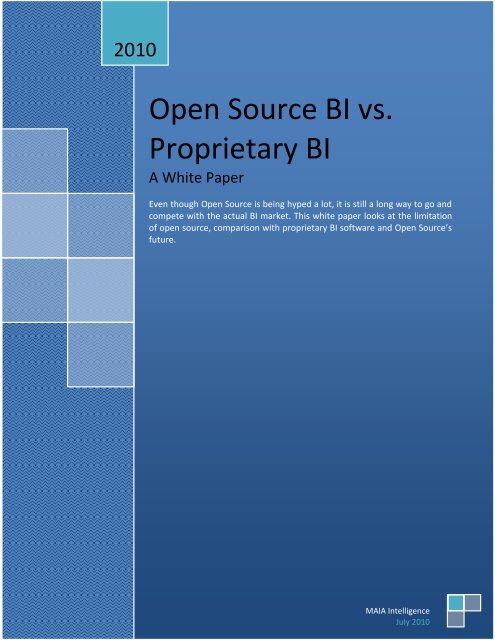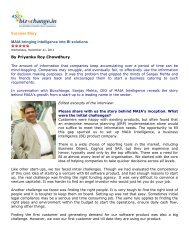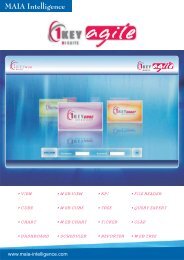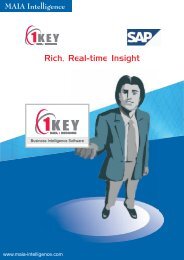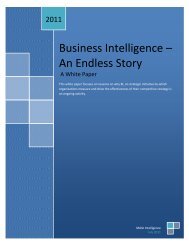Proprietary BI
Open Source BI vs. Proprietary BI - MAIA Intelligence
Open Source BI vs. Proprietary BI - MAIA Intelligence
- No tags were found...
Create successful ePaper yourself
Turn your PDF publications into a flip-book with our unique Google optimized e-Paper software.
2010<br />
Open Source <strong>BI</strong> vs.<br />
<strong>Proprietary</strong> <strong>BI</strong><br />
A White Paper<br />
Even though Open Source is being hyped a lot, it is still a long way to go and<br />
compete with the actual <strong>BI</strong> market. This white paper looks at the limitation<br />
of open source, comparison with proprietary <strong>BI</strong> software and Open Source’s<br />
future.<br />
July 2010<br />
MAIA Intelligence<br />
July 2010
Page2<br />
Open Source <strong>BI</strong> vs. <strong>Proprietary</strong> <strong>BI</strong> – A White Paper<br />
TABLE OF CONTENTS<br />
INTRODUCTION 3<br />
LIMITATIONS OF OPEN SOURCE <strong>BI</strong> 4<br />
PROPRIETARY <strong>BI</strong> SCORES HIGH OVER OS<strong>BI</strong> TOOLS 5<br />
COMPARISON OF OS<strong>BI</strong> WITH PROPRIETARY <strong>BI</strong> 6<br />
REASONS THAT CAUTION TO STEER TOWARDS OS<strong>BI</strong> 8<br />
OS<strong>BI</strong> IS ABOUT MULTIPLE INDEPENDENT PROJECTS 9<br />
OPEN SOURCE COMES FREE. OH REALLY? 10<br />
CONCLUSION 11<br />
ABOUT MAIA INTELLIGENCE 12<br />
The information contained in this document represents the current view of MAIA Intelligence on the issues discussed as of the date of publication.<br />
Because MAIA Intelligence must respond to changing market conditions, it should not be interpreted to be a commitment on the part of MAIA<br />
Intelligence, and MAIA Intelligence cannot guarantee the accuracy of any information presented after the date of publication.<br />
This white paper is for informational purposes only. MAIA Intelligence MAKES NO WARRANTIES, EXPRESS OR IMPLIED, IN THIS DOCUMENT.<br />
© 2009 MAIA Intelligence. All rights reserved.<br />
MAIA Intelligence, 1KEY, 1KEY Agile <strong>BI</strong> Suite, 1KEY MIS Server, 1KEY FCM and 1KEY Online are either registered trademarks or trademarks of MAIA<br />
Intelligence in India and/or other countries.<br />
The names of actual companies and products mentioned herein may be the trademarks of their respective owners. These include Microsoft, and<br />
Microsoft products and services.<br />
MAIA Intelligence White Paper July 2010
Page3<br />
Open Source <strong>BI</strong> vs. <strong>Proprietary</strong> <strong>BI</strong> – A White Paper<br />
1. INTRODUCTION<br />
Even though the Open Source Business Intelligence (OS<strong>BI</strong>)<br />
solutions are available today, still it has a long way to go and<br />
compete with the actual <strong>BI</strong> market. It relies on the organization<br />
adopting open source solutions for <strong>BI</strong>.<br />
Enterprise applications on Open Source including Business<br />
Intelligence may not be guaranteed certified licenses. <strong>BI</strong> being an<br />
important aspect of the Decision Support System of any<br />
organization, enterprises cannot rely on such unsupported<br />
applications. In case of the certified open source applications, the<br />
cost is more or less the same as that of a proprietary one. We<br />
have hardly come across any open source application being used<br />
across on desktop PC. Most of the business users across the<br />
organizations are on Windows and MAIA Intelligence being<br />
Microsoft Gold Partner has an opportunity to serve large chunk of<br />
customers.<br />
Open source, is being hyped, yet we question whether customers<br />
are adequately prepared to deal with the costs and risks of<br />
managing these environments. The allure of free software is<br />
accelerating the deployment of open source platforms, but open<br />
source is not free and may actually increase financial and business<br />
risk. In fact their total costs may be 5% to 20% more expensive<br />
than enterprise license applications like 1KEY Agile <strong>BI</strong> Suite.<br />
Hardly any growth in Open Source<br />
MAIA Intelligence does not see any growth happening on the<br />
open source platform, for any enterprise application. The reason<br />
being very simple like very few companies can know what they<br />
are really spending in case of open source software, preparation<br />
and planning takes longer than proprietary software, training<br />
costs are higher, resource availability is a major challenge.<br />
The biggest concern companies may have with open source is the<br />
lack of support. Even companies that have installed open source<br />
worry about support. Lack of support is one of the top reasons<br />
companies do not opt for Open Source.<br />
Initially appears to be an attractive solution may cause more work<br />
and increased costs than originally expected with open source<br />
software.<br />
MAIA Intelligence White Paper July 2010
Page4<br />
Open Source <strong>BI</strong> vs. <strong>Proprietary</strong> <strong>BI</strong> – A White Paper<br />
2. LIMITATIONS OF OPEN SOURCE <strong>BI</strong><br />
- There is no one with the power to restrict in a one-sided way<br />
how the software is used<br />
- There is no single entity on which the future of software<br />
depends<br />
- There is always a possibility of creating an alternative code<br />
- Lack of capabilities / features catering to all industries<br />
- Exposure to Intellectual Property theft issues<br />
- External developed modules are not properly or fully tested<br />
- Open source licenses and it’s restrictions – may not be fully<br />
open source<br />
- Lack of strategic product management at times – no one<br />
controls where it is heading to<br />
OS<strong>BI</strong> can help companies cut costs? Think again!<br />
Most of them have a perception that Open Source means FREE. It<br />
is not the case. It’s interesting to note that the pricing models<br />
being offered by open source vendors / partners for maintenance<br />
and support closely resemble the models used by proprietary<br />
software providers like MAIA Intelligence.<br />
The cost of software isn’t just the cost of <strong>BI</strong> software — still there<br />
may be need of investments in system management and<br />
monitoring tools, either direct investments to purchase new<br />
products, or investments to upgrade/deploy open source support<br />
in existing system management suites.<br />
MAIA Intelligence White Paper July 2010
Page5<br />
Open Source <strong>BI</strong> vs. <strong>Proprietary</strong> <strong>BI</strong> – A White Paper<br />
3. PROPRIETARY <strong>BI</strong> SCORES HIGH OVER OS<strong>BI</strong> TOOLS<br />
The cost of maintenance and support represents the bulk of<br />
spending. In fact maintenance and support are the biggest areas<br />
of spend in case of open source software. The testing processes<br />
are more complex and time consuming. Open Source software<br />
does not integrate well with other platforms and application<br />
suites in different environments. Companies opting for Open<br />
Source software have to obtain maintenance and support from<br />
external heavy weight vendors / partners, even after significant<br />
investments in internal IT training. Open Source costs more than<br />
proprietary software. Even after planning pretty well, and a lot of<br />
training, testing takes longer than expected. The number of<br />
people being assigned to Open Source can be almost double when<br />
compared with proprietary software IT staff for the same number<br />
of servers. For some this is learning-curve related, but do not get<br />
surprise if it gets worst as one experience the unexpected.<br />
Open Source vendors are moving more aggressively to package<br />
consulting and support services for open source software,<br />
essentially commercializing open source.<br />
Open Source skills are expensive and hard to find. Companies can<br />
have a hard time finding qualified open source software<br />
personnel in the marketplace to support their projects. When<br />
such companies find third-party help, they have less leverage<br />
negotiating hourly rates than with other proprietary consulting<br />
resources. The outside help can cost an estimated 10% to 20%<br />
more per hour over similarly skilled proprietary software help.<br />
Long-term Open Source deployments conclude that operating<br />
expenses for some companies can overcome initial purchase<br />
savings, making the Open Source’s return on investment lower<br />
than that of proprietary software.<br />
Open Source solutions are generally low cost or (some offer free<br />
versions). What most customers don’t know is that there may be<br />
hidden costs to these low-cost or free solutions that may lead to<br />
increased costs in the long run as well as supportability issues.<br />
OS<strong>BI</strong> tools can never become a mainstream deployment option<br />
for any kinds of <strong>BI</strong> usage.<br />
MAIA Intelligence White Paper July 2010
Page6<br />
Open Source <strong>BI</strong> vs. <strong>Proprietary</strong> <strong>BI</strong> – A White Paper<br />
4. COMPARISON OF OS<strong>BI</strong> WITH PROPRIETARY <strong>BI</strong><br />
End user support: OS<strong>BI</strong> has poor support, consultancy and training<br />
due to improper documentation of developed modules from<br />
various sources outside the parent company. Whereas <strong>Proprietary</strong><br />
has availability of timely helpdesk & technical support that is<br />
needed for big and stable enterprises<br />
TCO: OS<strong>BI</strong> has higher cost of installation and customization<br />
leading to higher lifestyle cost. On the other hand <strong>Proprietary</strong> <strong>BI</strong><br />
has low TCO primarily because of ease of use and hence low<br />
training costs and reduced implementation time.<br />
Innovation: Most of the OS<strong>BI</strong> don’t upgrade their application<br />
architectures and work on old-fashioned code written by different<br />
developers around the world. Well-built architecture provides all<br />
sort of business feature for various industries in case of<br />
<strong>Proprietary</strong> <strong>BI</strong>. In addition, planned architectural updates are also<br />
available so that existing component don’t cease operating.<br />
Interoperability: While commercial OS<strong>BI</strong> is being adopted within<br />
most of the smaller companies, there are obstacles slowing their<br />
adoption, particularly around interoperability. <strong>Proprietary</strong> <strong>BI</strong> is<br />
committed to interoperability in multi-vendor environments,<br />
hardware, software, network, data warehouse, ETL, analytics.<br />
Compatibility & Integration: Commercial OS<strong>BI</strong> are not free and<br />
easy to integrate with other applications. Excellent integrations<br />
with all different technology is available in most of the <strong>Proprietary</strong><br />
<strong>BI</strong> tools.<br />
Security & Administration: Security support, administration and a<br />
metadata layer is lacking with most of the commercial OS<strong>BI</strong>.<br />
<strong>Proprietary</strong> <strong>BI</strong> like 1KEY <strong>BI</strong> supports all sorts of user security using<br />
LDAP or Active Directory (ADS) and easy administration with 1KEY<br />
Console.<br />
Application Documentation: Biggest problem in case of OS<strong>BI</strong> is<br />
unavailability of documentation – functional or technical.<br />
<strong>Proprietary</strong> application provides better documentation. 1KEY<br />
Agile <strong>BI</strong> Suite comes with the help manuals for developers’ users<br />
of desktop and web.<br />
MAIA Intelligence White Paper July 2010
Page7<br />
Open Source <strong>BI</strong> vs. <strong>Proprietary</strong> <strong>BI</strong> – A White Paper<br />
5. REASONS THAT CAUTION TO STEER TOWARDS OS<strong>BI</strong><br />
Open source software are not reliable, due to the fact that there<br />
is little money put into development, and anyone can view, edit,<br />
and redistribute. There is often no qualified support available, the<br />
only support, if any is usually via forums and other users. Many<br />
open source programs are not compatible with Windows and<br />
other applications, often causing the installation costs to increase.<br />
As open source software is edited and redistributed by many<br />
users, there is no guarantee of regular updates, so your software<br />
can easily become outdated very quickly.<br />
If OS<strong>BI</strong> alternatives are available, why do organizations go for the<br />
proprietary versions and spend so much money on non-free<br />
source software? Contrary to the popular beliefs, the open source<br />
software is not as free as it seems. In fact sometimes it can prove<br />
to be more expensive than the proprietary software. Here are a<br />
few reasons that caution most of the serious organizations to<br />
steer clear of open source software applications:<br />
Most open source software applications are not reliable:<br />
Although multinational companies like IBM and Sun Microsystems<br />
are backing the open source software movement, there are no<br />
great financial stakes involved and the motivation mostly<br />
originates from a prevalent anti-Microsoft feeling. So there is no<br />
clear-cut discipline in this field and everything is emotion driven.<br />
Most of the developers and promoters of free source software<br />
believe in an obscure, idealistic world where intellectual property<br />
rights do not exist and software companies do not sell commercial<br />
software. Hence most of the applications are not reliable and you<br />
cannot run critical business operations on them.<br />
No support exists for open source software: Once you decide to<br />
use open source software, you are on your own. Agreed, that lots<br />
of help is available on the Internet and there are many selfmotivated<br />
forums that can help you install and run open source<br />
software, there is no qualified support available. You have to<br />
figure out on your own how to install and use applications<br />
without sabotaging your data and hardware. For instance, every<br />
second kid in the neighborhood exhorts you to ditch Windows<br />
and switch to Linux; many have lost their years of data trying to<br />
make the shift. No help documents and manuals are made<br />
available since the software is being changed every second week.<br />
MAIA Intelligence White Paper July 2010
Page8<br />
Open Source <strong>BI</strong> vs. <strong>Proprietary</strong> <strong>BI</strong> – A White Paper<br />
Higher installation costs: It is a total misconception that you save<br />
money by switching over to open source software. More than<br />
99% of PCs and laptops come with Windows operating system<br />
preinstalled and very few open source software applications<br />
adjust well with Windows. I don’t mean to say that once we are<br />
stuck with Windows we shouldn’t try another operating system;<br />
the incompatibilities are there just because nobody cares for the<br />
quality of the software. After the installation — if at all you can<br />
install it without destroying your digital resources — you have to<br />
put lots of effort into integrating the applications and make them<br />
give some decent output. Further, many open source software<br />
applications depend on the whims and fancies of the developers<br />
and they are not specifically developed by keeping the end user in<br />
mind; so once you decide to use it you have to really figure out<br />
how to excess various things. Sometimes even the menu<br />
conventions are not followed.<br />
Incompatibility: Another great problem is that most of the open<br />
source applications are incompatible with the present day<br />
gadgets. For instance if you use some open source operating<br />
system you can forget about the cool plug and play hardware that<br />
you have been using for so many years. Sometimes people can’t<br />
even get their modems working with open source operating<br />
systems.<br />
Technical support too is costlier compared to proprietary<br />
software because people who provide support for free source and<br />
open source software expect to earn lots of money for providing<br />
support. In fact this is the only revenue model perceived in favor<br />
of the open source software movement.<br />
No guarantee of updates: Who will be bound to give you regular<br />
updates when you are not paying for the open source software?<br />
You can get stuck with the same old version for years without<br />
ever getting an update.<br />
Hence open source software shouldn’t be promoted as a<br />
proprietary alternative.<br />
MAIA Intelligence White Paper July 2010
Page9<br />
Open Source <strong>BI</strong> vs. <strong>Proprietary</strong> <strong>BI</strong> – A White Paper<br />
6. OS<strong>BI</strong> IS ABOUT MULTIPLE INDEPENDENT PROJECTS<br />
OS<strong>BI</strong> solutions are assembled from distinct, independent Open<br />
Source developer communities and have little to no common<br />
direction. It is challenging enough to guide a single Open Source<br />
project towards a common goal once it reaches a certain size, but<br />
never has Open Source been able to channel multiple<br />
independent projects into a single, coherent solution.<br />
Open Source Challenges: Programming Complexity<br />
Given that each Open Source solution grew up from a series of<br />
independent, java-based developer communities, it is not<br />
surprising that Open Source solutions retain that programmer’s<br />
mindset. Documentation is riddled with references to Java class<br />
definitions and Java technologies. This requires technical depth<br />
and places a significant burden on <strong>BI</strong> implementers to develop<br />
Java programming and platform integration skills – thereby<br />
creating staffing challenges and further increasing staffing costs.<br />
MAIA Intelligence White Paper July 2010
Page10<br />
Open Source <strong>BI</strong> vs. <strong>Proprietary</strong> <strong>BI</strong> – A White Paper<br />
7. OPEN SOURCE COMES FREE. OH REALLY?<br />
Licenses may be free; management of licensing is not in case of<br />
open source. There are several different licensing models<br />
companies can use with open source. The choice of licensing<br />
models will depend on several factors and the most important —<br />
will the customer change the code? Companies looking for open<br />
source licensing, will not only cost significantly more money, it can<br />
also dramatically increase the risk to the organization as a whole.<br />
Companies have understood for a long time that it costs much<br />
more money to support a custom or customized environment<br />
than it does to support a packaged software environment. Open<br />
source is no different.<br />
Open source technologies are not without risk. One of the<br />
primary reasons proprietary software companies exist is to shift<br />
the burden of maintenance, upgrades, and support away from<br />
internal IT. <strong>Proprietary</strong> software companies take on the burden of<br />
operability, provide warranties on workmanship, defend against<br />
copyright infringements and intellectual property claims, and<br />
commit to supporting these platforms for specified periods of<br />
time. The open source movement shifts all of those burdens to<br />
the customer.<br />
Open source advocates say these platforms are more secure than<br />
proprietary software because they are open. We believe the<br />
relatively small footprint Open Source components within the<br />
enterprise, is the biggest reason there haven’t been more hacker<br />
attacks. It is not at all uncommon for a company to have 50<br />
Windows servers, 3 UNIX servers, and 2 Linux servers. Which<br />
platform do you think hackers will target? Companies should not<br />
be lulled into a false sense of security with open source. It is open,<br />
available to anyone who wants to do harm, and, therefore, needs<br />
to have special attention with testing and security.<br />
MAIA Intelligence White Paper July 2010
Page11<br />
Open Source <strong>BI</strong> vs. <strong>Proprietary</strong> <strong>BI</strong> – A White Paper<br />
8. CONCLUSION<br />
Open Source <strong>BI</strong> tools are yet to mature to have richness in<br />
features<br />
Any code changes made to these Open source platforms may be<br />
disastrous. Undoubtedly, proprietary <strong>BI</strong> applications deliver more<br />
comprehensive solution for performance management, planning,<br />
querying, analysis, reporting and strategic information<br />
management across the industry verticals.<br />
And when it comes to support availability and the concerns for<br />
protection of investments; proprietary companies are less likely to<br />
stop functioning then many of the upcoming unstructured open<br />
source communities.<br />
OS<strong>BI</strong> is dependent on the community collaboration effort that<br />
surrounds Open Source development in general.<br />
It has been said that Open Source is the best option for SME<br />
which makes <strong>BI</strong> tools within their reach. MAIA Intelligence already<br />
has a <strong>BI</strong> offering for SMEs 1KEY MIS Server and has significant<br />
number of customers in this segment using the solution.<br />
MAIA Intelligence White Paper July 2010
Page12<br />
Open Source <strong>BI</strong> vs. <strong>Proprietary</strong> <strong>BI</strong> – A White Paper<br />
MAIA Intelligence is a software product company in Business Intelligence (<strong>BI</strong>) MIS reporting and<br />
analysis space. MAIA Intelligence, a young and innovative company is committed to developing<br />
powerful yet affordable and scalable <strong>BI</strong> solutions, has emerged as a growing entity in the market<br />
place. MAIA Intelligence’s flagship offering 1KEY <strong>BI</strong> caters to strategic, tactical and operational<br />
user’s requirements across the organization with a self-serve <strong>BI</strong> tool for dynamic MIS, ad-hoc<br />
reporting and complex analysis. With its mission to democratize <strong>BI</strong>, MAIA has made <strong>BI</strong> available<br />
to masses. Commenced in the year 2006, MAIA Intelligence, has always strived to meet the<br />
needs of corporate implementations, application service providers and value-added resellers.<br />
MAIA’s innovation has revolutionized the way <strong>BI</strong> can be deployed. With installation & database<br />
connectivity happening in 2 working days, organizations are ready to deploy <strong>BI</strong> from the 3rd day<br />
with instant dynamic reports. For more information, visit www.maia-intelligence.com.<br />
1KEY <strong>BI</strong> helps companies take informed and better decisions at all levels.<br />
1KEY <strong>BI</strong> is developed on Microsoft .NET Framework 3.5. It has been specifically designed to cater<br />
to high levels of simultaneous access to huge data reporting on various platforms of Windows<br />
and databases. 1KEY <strong>BI</strong> can accommodate thousands of users, connect multiple applications,<br />
integrate disparate data sources and deliver visually stunning, multi-formatted and flexible cross<br />
functional reports and analytics.<br />
The solution connects and communicates to all type of applications, irrespective of the database<br />
used at the backend. It helps the organizations to analyze and derive more meaningful and<br />
accurate information that will facilitate faster and, consequently profitable business decisions.<br />
1KEY <strong>BI</strong> provides visual reporting and guided analysis for business users. 1KEY <strong>BI</strong> software<br />
product is geared toward business users with needs not met within their existing <strong>BI</strong> tools. It<br />
provides a very intuitive, interactive and highly visual interface that lets users see problems,<br />
both summary and details, in a very understandable way.<br />
1KEY <strong>BI</strong> caters to any industry vertical including Manufacturing, Banking, Financial Services and<br />
Insurance (BFSI), Healthcare & Pharmaceutical, Services, Construction & Allied, Public Sector,<br />
Information Technology Enabled Services (ITES), Retail, Logistics, and Hospitality. The solution<br />
caters to the reporting and analysis demands of business users across the organization in all<br />
horizontals like Purchase & Procurement, Manufacturing & Distribution, Sales & Marketing, HR,<br />
and Finance & Accounts.<br />
1KEY consists of wide range of components, with a variety of features to suit different business<br />
requirements.<br />
MAIA Intelligence White Paper July 2010


